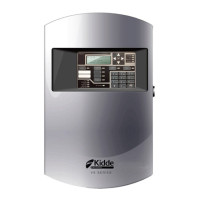
Do you have a question about the Kidde VS Series and is the answer not in the manual?
| Power Source | 120V AC |
|---|---|
| Battery Backup | 9V battery |
| Sensor Type | Photoelectric |
| Alarm Sound Level | 85 dB at 10 feet |
| Hush Feature | Yes |
| Test Button | Yes |
| LED Indicator | Yes |
| Mounting Type | Wall or ceiling |
| Compliance | UL 217 |
Details the process for mounting the panel backbox, including surface and semiflush options.
Instructions for installing the control unit electronics into the panel backbox.
Covers circuit specifications and wiring procedures for the panel's AC power supply.
Instructions for connecting standby batteries to the control panel's battery circuit.
Explains wiring specifications and procedures for notification appliance circuits.
Details wiring for addressable device circuits supporting detectors and modules.
Covers wiring for the optional SA-DACT for central station communication over a telephone line.
Details wiring for the optional SA-ETH card for Ethernet network connections.
Lists programming features and options limited to comply with listing agency requirements.
Details the two levels of passwords (Level 1 and Level 2) for accessing panel functions.
Lists the default settings for passwords, panel operation, and configuration.
Explains how device types determine point operations and lists available device types.
Procedure for setting the panel's current time and date, a prerequisite for programming commands.
Details the process of automatically configuring the panel with default settings for devices, NACs, and expansion cards.
Method for manually programming the panel with custom settings for various options.
Instructions for using fast groups, adding members, setting activation counts, and managing correlation groups.
Options for configuring panel settings like NACs, annunciators, dialer, network, and printer.
Explains the two operating modes: Normal and Off-Normal, and their system responses.
Details the capabilities of the 4-line, 20-character LCD for programming and event notification.
Provides additional information on secondary screens for detailed event data like loop, device, and serial numbers.
Explains the meaning of each LED indicator on the panel for system events and status.
Details the functions of common control buttons like Reset, ACK/Panel Silence, Signal Silence, and Drill.
Procedure to restore the fire alarm system to normal operation after an event.
Steps to disable or enable individual devices, typically for maintenance, preventing event reporting.
Procedure to disable or enable zones, preventing event messages while allowing normal function.
How to disable or enable specific panel events to control their display, printing, or reporting.
Outlines the fundamental steps for accessing and printing reports from the panel.
Describes how to view and print reports detailing system or user events stored in memory.
Provides reports on detector status, including dirt percentage and sensitivity settings.
Generates reports on active, alarm, supervisory, trouble, disabled, or other system points.
Displays comprehensive information about the system’s current configuration settings.
Provides reports on communication performance for devices on a loop.
Displays information about internal fault events for technical support troubleshooting.
Quickly checks the system for ground faults, reducing check time for troubleshooting.
Determines which loop devices are not communicating and generates a report for troubleshooting.
Procedures for testing panel operation in alarm, supervisory, and trouble modes.
Activates detectors or input modules to test their operation and programming.
Allows testing of individual zones or devices without causing an actual alarm condition.
Instructions for using HyperTerminal to gather information for troubleshooting system faults.
Procedure for replacing a device while it is in alarm, detailing panel and device operation.
Provides detailed specifications for VS1 and VS4 panels, including device loops, power, and circuits.
Worksheet to determine the minimum amp hour capacity required for the panel's standby battery.
Methods to determine maximum cable length for notification appliance circuits (NACs).
Worksheet to calculate maximum wire length for a device loop based on wire type and components.
Worksheet to document system programming options for NACs, annunciators, dialers, and networks.
Worksheet to document control panel programming options like language, marketplace, and delays.
Worksheet to document configuration and settings for each zone on the system.
Describes applications where an audible detector base sounds an alarm when its detector is activated.
Covers applications where sounder bases are triggered by associated correlation groups for zone and system alarms.
Explains how detectors and sounder bases are grouped by zone to sound alarms simultaneously.
Describes applications where all sounder bases sound when any alarm signal initiating device is activated.
Provides instructions for creating in-suite signal silence applications using correlation groups in residential buildings.
Correlates different device types with their respective personality codes for programming.
Guidelines for configuring and using REL modules and panel events, including configuration restrictions.
Lists possible fault messages displayed on the panel’s LCD for the REL module.
Details the power riser and signaling line circuit specifications for the REL module.